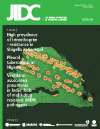Serotypes and antimicrobial resistance profiles of Salmonella isolates from pigs at slaughter in Kenya
DOI:
https://doi.org/10.3855/jidc.446Keywords:
Serotypes, Antimicrobial Resistance, Salmonella, Pigs, KenyaAbstract
Background: Salmonellosis is considered one of the most widespread food-borne zoonoses in industrialized as well as developing countries. The presence of Salmonella in food animals at slaughter and the consequent cross-contamination of edible carcass tissues present a significant food safety hazard.
Methodology: Samples were collected from randomly selected pigs at the Ndumbuini abattoir in Nairobi. Isolates were confirmed to be Salmonella by biochemical tests and characterised by serotyping, phage typing and plasmid analysis. Minimum inhibitory concentrations (MICs) of eight antimicrobials were determined and the resistant isolates were screened for resistance genes by PCR.
Results: Sixteen (13.8%) of 116 samples were positive for Salmonella. Three Salmonella enterica subsp. enterica serovars, namely Saintpaul, Braenderup, and Heidelberg were identified, S. Saintpaul being predominant. Antimicrobial resistance was found in 35.7% of the isolates. The S. Heidelberg isolates were susceptible to all the antimicrobials tested. Multidrug resistance was found in 7.1% of the Salmonella isolates. Plasmids were only detected in S. Heidelberg. Ampicillin resistance was based on expression of a blaTEM gene, while chloramphenicol, streptomycin, and tetracycline resistances were encoded by the genes catA1, strA, and tet(A), respectively.
Conclusions: Pigs may serve as reservoirs of antimicrobial resistant Salmonella and slaughterhouse cross-contamination of pork may be a food safety risk.
Downloads
Published
How to Cite
Issue
Section
License
Authors who publish with this journal agree to the following terms:
- Authors retain copyright and grant the journal right of first publication with the work simultaneously licensed under a Creative Commons Attribution License that allows others to share the work with an acknowledgement of the work's authorship and initial publication in this journal.
- Authors are able to enter into separate, additional contractual arrangements for the non-exclusive distribution of the journal's published version of the work (e.g., post it to an institutional repository or publish it in a book), with an acknowledgement of its initial publication in this journal.
- Authors are permitted and encouraged to post their work online (e.g., in institutional repositories or on their website) prior to and during the submission process, as it can lead to productive exchanges, as well as earlier and greater citation of published work (See The Effect of Open Access).








